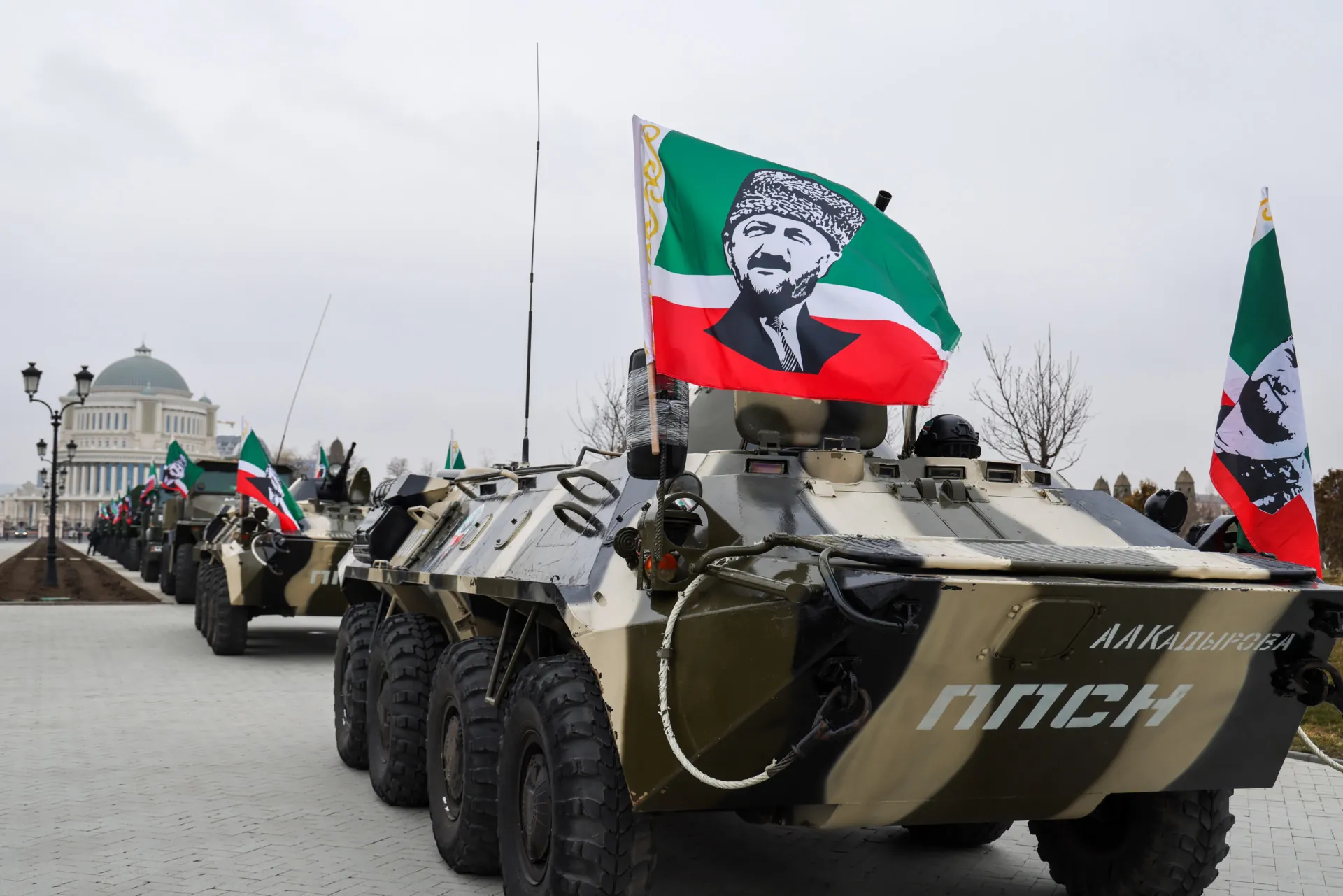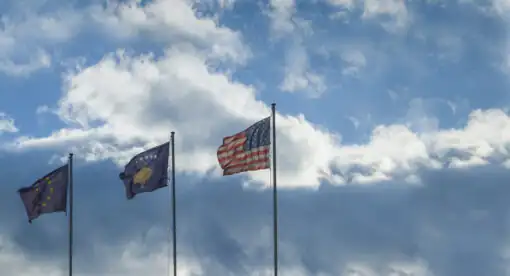Since the beginning of Russia’s large-scale invasion of Ukraine in the early hours of Feb. 25, various media outlets and open-source intelligence Twitter accounts reported sightings of Chechen fighters, commanded by warlord and Russian-backed Chechen President Ramzan Kadyrov, arriving in Belarus. It was clear that the involvement of these fighters – known as the Kadyrovtsy (Kadyrovites in English) – was not only an operational reinforcement for Russia, opening the northern route to Kyiv, but also a propaganda tool designed to spread fear of the atrocities the Chechens might inflict on Ukrainians in their path.
Russian state propaganda and Kadyrov, a close ally of Russian President Vladimir Putin, boasted of having up to 70,000 pro-Russia Chechen fighters who were prepared to fight for Russia in Ukraine. Kadyrov personally warned the Ukrainian people to overthrow their government or face a takeover of Kyiv. However, the Kadyrovtsy’s poor fighting performance has revealed the militia’s military and administrative inadequacies and Kadyrov’s arrogance owing to his obsession with social media appearances, as indicated by their lack of operational security, combat discipline, and readiness. Moreover, with the presence of opposing Chechen factions – Adam Osmaev, leader of the Chechen Dzhokhar Dudayev Volunteer Battalion that has been fighting Russians in Donbass since 2014, released a video denouncing Kadyrov and his army’s intervention – Chechnya’s internal conflict threatens to spill into Ukraine.
The Kadyrovtsy: Who and What Are They?
The pro-Moscow North Caucasian battalion known as the Kadyrovtsy – part of the National Guard Service – is Kadyrov’s private militia. The Kadyrovtsy began as a Chechen separatist group led by Kadyrov’s father, Akhmad Kadyrov, who served as the chief mufti of the Chechen Republic of Ichkeria during and after the First Chechen War in the 1990s. The conflict followed the Russian and Chechen elites’ failure to reach an agreement on Chechnya’s status within the Russian Federation and radicalized a generation of Chechens and disillusioned the youth in the North Caucasus. The senior Kadyrov then decided to abandon Chechen’s then-nationalist leader Aslan Maskhadov and the Chechen separatist cause and defect to the Federation during the Second Chechen War in response to the growing influence of Wahhabism among the rebels. The ideas of the puritanical sect clash with Chechnya’s predominantly Sufi norms.
Following Akhmad’s assassination by Chechen jihadists in 2004, the younger Kadyrov assumed leadership. He converted a significant number of Chechen militants into members of his faithful entourage, the Kadyrovtsy, and earned unique privileges within Russia’s governing class as Chechnya’s Muslim strongman while pacifying the region and maintaining political order. Moscow allowed Kadyrov great autonomous power, while the Kadyrovtsy unit became the republic’s principal security force, with Putin’s approval. They operate outside Russia’s normal military command structure while assuming federated control at the local level.
The Kadyrovtsy operate on clan-based recruitment, in service to the state and the clan that controls them. Their vicious methods to subdue the transnational jihadist Vilayat Caucasus (Caucasus Emirate) insurgency have been widely ascribed to the existence of a larger North Caucasus rebel force influenced by the Salafist-jihadist narrative inspired by the Saudi version of Islam. The Kremlin’s counterinsurgency and counterterrorism operations against the Caucasus insurgents has been outsourced to the Kadyrovtsy.
Escalating the Operational Tempo
The Kadyrovtsy have been known to provide support to Moscow’s security forces and military campaigns before, including in Lebanon, Georgia, and most recently Syria in 2015. Moscow also engaged the Kadyrovtsy to provide additional security for Russia’s 2014 Winter Olympics and to support counterterrorism cooperation between the Kremlin and Chinese military forces in the Xinjiang Uyghur Autonomous Region. During the Syrian conflict, Kadyrov reportedly persuaded Moscow to deploy the Kadyrovtsy to Aleppo as reinforcements for Syrian President Bashar al-Assad’s forces. Through the networks that Kadyrov cultivated in Syria, Russia was hopeful that their efforts would elicit a soft approach to improve Russia’s image with Syrians via humanitarian aid and win over Russia’s own Muslim audience at home, but here they failed to achieve their political objectives within the complex dynamics of the Syrian conflict.
It has been widely reported that the Chechens, along with Russia’s mercenary Wagner Group, have been inserted into Ukraine with a “kill list” printed on playing cards with the mission to assassinate key Ukrainian personalities, including Ukrainian President Volodymyr Zelenskyy and his wife and children. Allegedly at Kadyrov’s request, thousands of Kadyrovtsy have been dispatched to Ukraine to assist Russian forces alongside with the Wagner Group. Kadyrov considers Moscow’s invasion to be too slow and demanded an escalation of the operational pace to be escalated, urging the Kremlin to deploy his militia for a “decisive assault.” Kadyrov has personally promised monetary rewards to the Chechen fighters as an incentive for tracking down Ukrainian government officials. (Zelenskyy, meanwhile, has announced the formation of the International Legion of Territorial Defense of Ukraine and invited foreign volunteers to bolster his forces, but it is unclear how many will answer this call.)
The day after the invasion began, photographs began circulating online showing the battle-hardened pro-Putin cadres from the Special Chechen Battalion and the Kadyrovtsy leaving Grozny and entering Ukraine from Belarus in vehicles marked with “V”. According to reports, the armored column was traveling near Hostomel, 10 miles (16 kilometers) northwest of Kyiv, when a Ukrainian Alpha Group ambushed them and destroyed the convoy with a drone strike. Among the 70 dead was Gen. Magomed Tushayev, the commander of the 141st Motorized Brigade of the Russian Chechen Guard and Kadyrov’s right-hand man. Tushayev’s death is considered to be one of the most devastating blows to the Chechen militia’s image of being indestructible, which the Kremlin’s propaganda outlets aggressively hyped up in the weeks before the invasion.
Brand for Brutality: Hard-Earned or Hyped-Up?
Pro-Putin and Russian state propaganda online and in other media has been responsible for the Kadyrovtsy’s formidable image. In reality, the fighters are not doing well on the battlefield, and many have been eliminated. By the end of the first week of the conflict, the Kadyrovtsy’s ferocity and Russia’s might had begun to diminish. The Kadyrovtsy’s intimidating public presence, which was meticulously crafted to mythologize their ruthless masculinity, enhance their status as savage fighters, and exaggerate their discipline, was beginning to look manufactured.
Several military commentators have highlighted the obvious impracticalities of the Kadyrovtsy’s uniforms and personal gear. For instance, black is not an effective camouflage for the woods of Ukraine, and Kadyrov was seen recently wearing combat boots from Prada. Their stylish visuals of beards and muscles and awe-inspiring videos of martial arts prowess seem to be lifted straight from the Islamic State propaganda playbook.
It is now evident that certain elements of Russian state media, such as Russia Today, have been exploiting the Kadyrovtsy’s previous war crimes to embellish much of the Chechen cadre’s lethality and combat experience. It is unclear what training the Chechens have actually received, as there is little evidence that the Russians have sent Spetznaz “advisers” to be embedded in the units. In all likelihood, the Kadyrovtsy remain poorly trained as the result of frequent reorganization and fragmentation. In Ukraine, the Kadyrovtsy would likely be used for urban operations and performing security sweeps for the Russian forces.
Much of the propaganda footage has focused on the Kadyrovtsy’s viciousness in clearing out Chechen insurgent cells. In Ukraine, however, they are not battling ill-equipped separatist cells, but well-prepared organized resistance and entrenched adversaries who are highly motivated to defend their home. Being a Praetorian Guard-type force, the Kadyrovtsy’s main duties are to guard Kadyrov as his close protection entourage, not expeditionary fighting. They were not trained for the rigors of conventional warfare and were deployed to unfamiliar terrain, supplied with little intelligence and no coordination with regular army units. Therefore, their operational effectiveness has not lived up to the hype. They lack the necessary force protection measures, logistics support, and basic tactics needed to achieve their objectives. The Kadyrovtsy’s gruesome reputation for brutality and atrocities supports psychological warfare, not combat effectiveness.
For years, Russian media and propaganda outfits have optimized social media for their disinformation campaigns and malign influence operations to demoralize their target audiences and bolster Russia’s image, including the Kadyrovtsy’s reputation. But these measures sometimes backfire on the battleground. For instance, video footage of the Chechen special forces gathered for Friday prayers in a Belarusian forest before going to war was clearly designed to intimidate their enemies. However, geotagging gave the Ukrainian defenders crucial targeting information. Similarly, Ukrainian defenders and Alpha Special Forces troops also benefited from photographs released online showing Chechens traveling in vehicles marked “V.” This helped them prepare the ambush near Hostomel in which Tushayev was killed. There have also been Ukrainian government-confirmed reports of three botched assassination attempts on Zelenskyy; in one case, Chechen special forces allegedly were behind the attempt but were “neutralized.”
Key Lessons
The Russians have spent years integrating the Kadyrovtsy into their military efforts to subdue their political adversaries, quell Muslim discontent at home, and revive their appeal and status as a global superpower. Instead, this war has exposed the fighters’ military weakness and administrative deficiencies along with Kadyrov’s conceit due to his preoccupation with his image on social media, which inspired him to work harder at nurturing the Chechens’ violent brand for propaganda than at developing his forces’ capabilities. They imagined themselves to be the formidable special forces unit they depicted themselves to be. But the lack of appropriate recruit selection, training, and planning procedures had led them to grievous tactical failures that inflicted psychological damage to Putin’s confidence. Moreover, the 2015 Boris Nemtsov’s assassination in London, disappearances in Chechnya, along with Kadyrov’s leeching from Moscow, have made the warlord a thorn in Putin’s side that he has tolerated for years Putin’s difficulties in controlling Kadyrov have exposed a serious principal-agent problem. Putin’s reliance on Kadyrov’s military support is contingent on Chechnya’s popular support, which is already divided on the Kremlin.
The Kadyrovtsy’s poor fighting performance is a shocking betrayal of their inadequate discipline and capabilities. In a classic case of “talking the talk,” the Chechens placed too much importance on achieving psychological effects through presence, posture, and profile, as well as propaganda. But they failed to “walk the walk,” as shown by their lack of operational security, combat discipline, and preparedness for Ukrainian resistance.
Given the circumstances, the presence of anti-Russian battle-hardened Chechen militias who may be similarly undisciplined may not necessarily work in the Ukrainian defenders’ best interests. Their zeal to exact personal vendettas on the battlefield is likely to exacerbate their lack of discipline, making them resistant to command and control, worsening the bloodshed and creating further societal fissures. While the Ukrainian defenders would welcome the assistance, it would also be in their best interests to manage those participating on the ground as effectively as possible.
Munira Mustaffa is a Non-Resident Fellow at the New Lines Institute, and a Fellow at Verve Research where she focuses on the relationship between militaries and societies in Southeast Asia. Mustaffa has worked as a security and intelligence practitioner, and researcher in the private, government and military sectors. Her commentary and work on terrorism, extremism, and cyber warfare have been published by several publications, including NATO Strategic Communications Centre of Excellence (STRATCOMCOE) and Global Network on Extremism and Technology (GNET) Insights. She earned a masters in Countering Organized Crime and Terrorism from the University College of London and tweets at @muniramustaffa.
The views expressed in this article are those of the author and not an official policy or position of the New Lines Institute.






